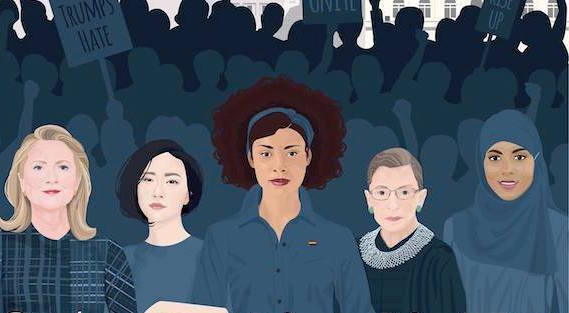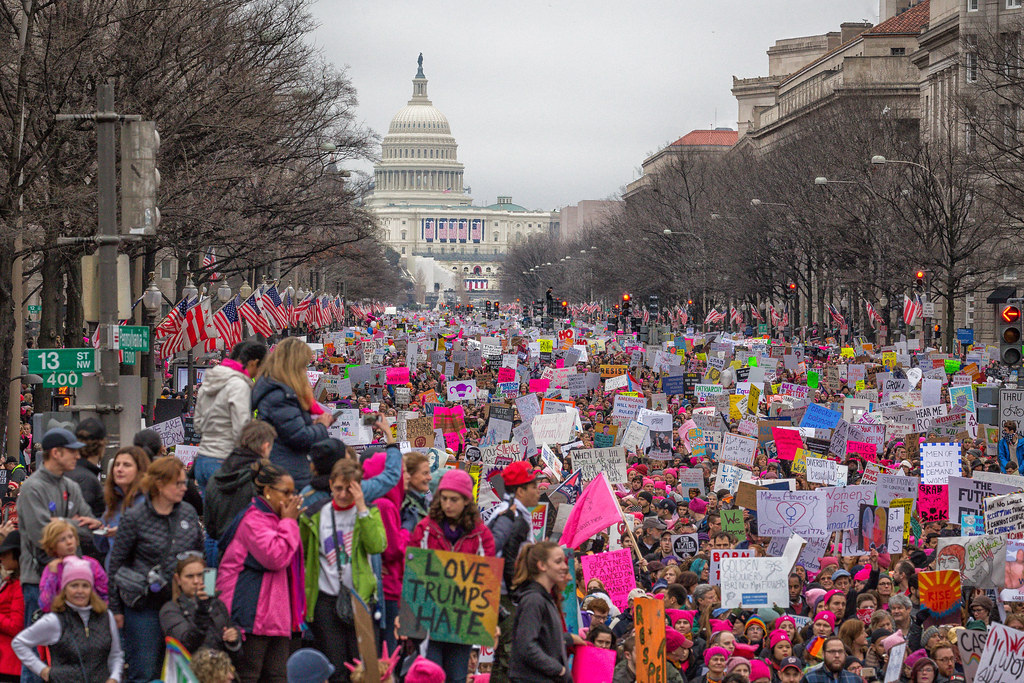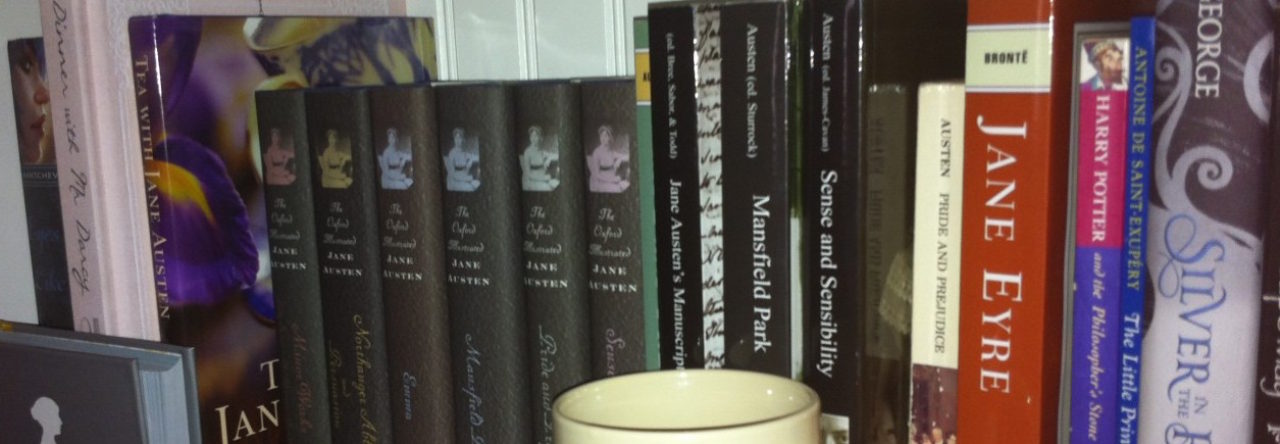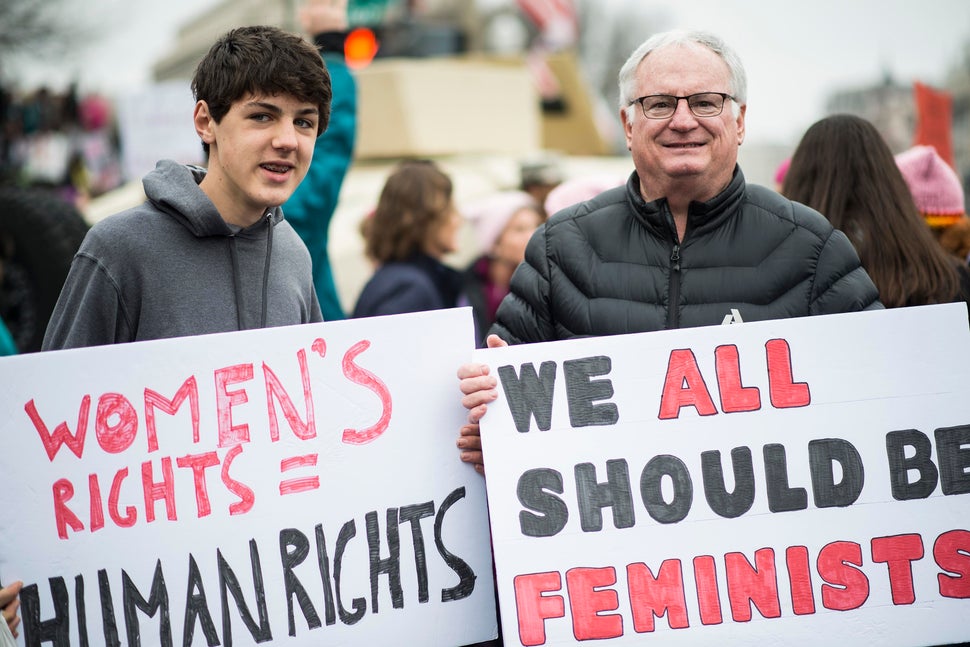
In the wake of Women’s History Month and various female-driven campaigns of the past months, inspiring women’s stories are getting great exposure. But despite present passion, if we don’t also look at stories of past failings in feminism (as documented in the play The Heidi Chronicles) and what it really means to be feminist, we may be doomed to failure.
In spite of all the misogyny and threatened rights present in government recently, I’ve been so inspired by the way women have come together in recent months. The Women’s March and associated marches that took place all over the world on January 21 may have come together quickly, but there was enough time for a grassroots marketing campaign to gain ground.
My favorite image associated with the marches is the one above by Narya Marcille, which my mom and I used as temporary profile pictures to support from afar.
What I love most is the variety of women it depicts. The way the Washington March was marketed by the women who originally put it together, they wanted it to be inclusive of more than one type of woman, or, as Kimberlé Williams Crenshaw coined it, “intersectional.” Seeing all those crowds on TV seemed to reflect what was depicted in that image. For a moment, I thought maybe the next four years could be okay if we all showed up like this.

But then… things started to come out. Things that, from my privileged perspective, hadn’t occurred to me could happen. Transgender women who were inadvertently isolated by the hats tying womanhood to biological sex over gender. Native American women who felt they were silenced from voicing the issues of land rights that affected them specifically. Black women who wondered if the women around them would be so willing to fight for racial equality as they were for sexual and gender equality. And for good reason – it was white women, who might not be so different from me, who voted 53% for the administration now endangering women’s rights.
My heart plummeted. Another disappointment in a long line of disappointments in recent months.
I mean, let’s acknowledge there were plenty of stories of inclusion in the marches as well, that the fact it spread among women, allied men, children, elderly, and even beyond United States borders is something to be celebrated, especially considering how relatively quickly it all came together. No movement is perfect. But as much as we want unity, we can’t silence these stories of women let down by current efforts, women of color or trans women or women with physical and mental issues. If we do, it will eventually destroy us.
Because we’ve seen this happen before.
Heidi and History: The Heidi Chronicles on Second Wave Feminism

In 1988, The Heidi Chronicles premiered on Broadway. The Tony- and Pulitzer-Prize-winning play by the late Wendy Wasserstein observed twenty years of cultural shifts from the perspective of Heidi Holland, quiet, introspective, and described as “very bright.” In particular, Heidi gets caught up in the Second Wave Feminist movement, complete with picketing art museums and attending consciousness-raising rap sessions.
Again, this won the Pulitzer. Gloria Steinem, Nora Ephron, Meryl Streep, and Betty Friedan all saw the original production. In fact, Seinfeld was originally called “The Seinfeld Chronicles” in the play’s honor.
Yet when the play was revived for the first time in 2015 with Mad Men and upcoming The Handmaid’s Tale‘s Elisabeth Moss, the already limited run was cut short by a full three months due to low ticket sales.
I was lucky enough to see the show before it closed, and I can speak to how empty it was – my mom and I were at liberty to sit two or three rows ahead of where we were assigned in the mezzanine. Keep in mind, this was one of the smaller Broadway theaters.

This wasn’t a bad production. The reviewers generally liked it, and I absolutely loved it. It just didn’t catch on with theatergoers. Articles following the early closing wondered if Wasserstein’s work was no longer relevant to today’s audience. There were people who judged it even in its heyday for the protagonist being too passive, for feeling feminism failed her and moved on when so many were still fighting the good fight.
Now, in the light of increasing intersectionality, expanding feminism outside the individual empowerment and mainly white educated middle-class focus of Second Wave Feminism, The Heidi Chronicles‘s perspective comes off as more limited than it did in 1988.
But the play was only ever meant to be a single woman’s perspective on a broad movement. Wasserstein was a middle-class white woman reflecting what she saw around her, which was mostly middle-class white women (though it should be noted the revival did cast an Asian-American actress as Heidi’s best friend Susan, bringing some diversity to the discussion). And it was already a retrospective in 1988.
So, why not embrace those limits in marketing the revival? The Crucible was written in response to McCarthyism, yet we still find it relevant in countless revivals long after McCarthy fell from power. We know it was written in a certain time and place to respond to a specific problem, but also recognize the elements still relevant to us.
Looking at the ads for the Heidi Chronicles revival, we don’t see it marketed as a historically-relevant piece about feminism. The only thing potentially feminist about the ads is the pink and the woman at the center. Even then, she is flanked by her male costars in a manner that suggest a love triangle, which… is so far off base because one them confesses he’s gay in Act 1.
Heidi’s Modern Relevance
So maybe it’s not modern. Maybe it’s not universal to all women’s experiences. But maybe it doesn’t have to be. Maybe we just need to acknowledge that, messy and limited as it is, this is what modern feminism is descended from, and how some people still see it.
So many, even women, still think feminism was a “phase,” as the charismatic misogynist creep Scoop Rosenbaum puts it in the play. Yet many of the problems brought up in the play are still problems today. One of those problems is in fact the question of what feminism is, who it serves, and who it needs to serve.
The scene I mentioned above, where Heidi’s friend Peter confesses he’s gay? Let’s set the scene:

It’s 1974, and Heidi is protesting with a group of women outside the Chicago Art Institute for not including a proportional amount of female artists in its exhibits. She briefly separates from them to talk to Peter, who she’s always considered as a potential suitor along with a very good friend.
But then, he tells her he’s gay. She gets awkward, pretends she didn’t hear, wishing she could get back to her march. But Peter insists:
Heidi, I’m gay, okay?[…] And my liberation, my pursuit of happiness, and the pursuit of happiness of other men like me is just as politically and socially valid as hanging a couple of Goddamned painting because they were signed by someone named Nancy, Gladys, or Gilda. […] I am demanding your equal time and consideration. (Act 1, Scene 4)
Her protest-mate Debbie comes back before Heidi can respond. She asks that Peter leave them alone:
DEBBIE: […] I’m sorry. I can’t permit you to join us. This is a women’s march.
HEIDI: But I thought that our point was that this is our cultural institution. “Our” meaning everybody’s. Men and women. Him included.
DEBBIE: Heidi, you know this is a women’s march.
PETER: Heidi, you march. I’ll wait for you here.
HEIDI: (To Debbie) I’m sorry, I can’t leave my friend. (Act 1, Scene 4)
Debbie leaves disgusted, but nonetheless, Heidi hands Peter a sign, and they join the march on the curator’s office.
Now, imagine if we’d tried to block men out of the Women’s Marches in January? All the fathers, husbands, brothers, sons, gay and bisexual men, trans men and women, and allies who came out to support women. But this is where we came from. And some men still struggle to see how they can fit into this generation’s women’s movement. But they can, and they should, if the desire to listen and to help is there. Same goes for all groups of women who don’t fit the traditional mold of feminism. Even in 1988, a year before “intersectionality” was coined, Wasserstein saw this was important. As she frequently says through Heidi, “All people deserve to fulfill their potential.”
Heidi – A Feminist Cautionary Tale?
Feminism is not a static thing. It’s fluid, and has been since Heidi’s time. Back then, it transformed from rap sessions and marches and solidarity, to more about individual progress in the corporate world and “having it all.” When individual women found ways to get up the ladder in the 80s, many figured, “Well, I’m set. So we don’t need feminism anymore.” The sense of community faded as individual accomplishments were held up as examples of overall success. And any woman who couldn’t do both was doing it wrong.

This leaves Heidi, near the end of the play, in a crisis, leading to a scene-long monologue that has resonated with me since I saw the play as a teenager. As her speech in front of her high school alma mater on “Women: Where Are We Going?” dissolves into a rumination on a locker room incident, frustrated by feeling like she has to compete with and measure up to other women, she concludes, sadly:
I don’t blame the ladies in the locker room for how I feel. I don’t blame any of us. We’re all concerned, intelligent, good women.
It’s just that I feel stranded. [emphasis added] And I thought the whole point was that we wouldn’t feel stranded. I thought the point was that we were all in this together. (Act 2, Scene 4)
Perhaps this trend observed by Heidi and Wasserstein didn’t apply to all women striving for equality in the 80s. But it applied enough that women’s progress slowed considerably. And Heidi shows the damage this mindset causes. Not only was she left stranded, made to feel her choices were wrong, but so were the women unrepresented in the play or the movement.
Some women have always had to balance work, housework, and childrearing, with little financial gain or support due to racial inequality and/or poor background, and their needs were not heard. The gay rights movements too was stranded when they could have used women’s support as they struggled with AIDS in the 80s.
Right now, we are in flux. There are a lot of women out there who see what is happening and know it’s wrong. But 53% of white women still voted for an administration that expresses contempt for women. And even women who believe in women’s rights don’t all have the same idea of what feminism is and who it needs to represent.
I’m not saying we have to have the same mindset or lifestyle to make this work. That belies the point of diversifying. There’s a lot of conversation we need to have, and we’re getting there. But I think we each have to recognize whether we’re in this for all women or just for women like us. Because Heidi provides a cautionary tale to the latter – if we’re not willing to work together and help each other, we’re going to fizzle out all over again. And all this will be just another phase.
A Heroine for the 21st Century

In the final scene, Heidi adopts a baby girl. Though saddened at the lack of progress she has witnessed, Heidi sees Judy as a symbol of hope for the future, “a heroine for the twenty-first [century]” – a future Heidi intends to forge without a man by her side.
But Scoop, there’s a chance. Just a milli-notion. That Pierre Rosenbaum [Scoop’s son] and Judy Holland will meet on a plane over Chicago. […] And he’ll never tell her it’s either/or baby. And she’ll never think she’s worthless unless he lets her have it all. And maybe, just maybe, things will be a little better. And yes, that does make me happy. (Act 2, Scene 6)
Today, Judy Holland would be in her late 20s, a millennial just a few years older than me. What lessons did she take from her mother’s legacy, I wonder? And where would she disagree and grow beyond it? Would she and Heidi be taking part in the marches and strikes? Would she look out for those women who felt underrepresented, stranded as her mother had been? Would she and her mother wonder if, maybe this time, it won’t be just a phase?
I wish Wasserstein had lived on to hint at these answers. But perhaps it is up to us to write that story, as heroines of the twenty-first.
And this time, let’s not leave anyone stranded.
For more articles on life and storytelling, check out the home page or my other assorted works.
All the best!

